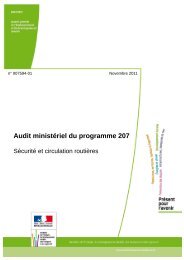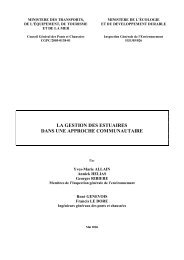Les bus et leurs points d'arrêt accessibles à tous - Portail ...
Les bus et leurs points d'arrêt accessibles à tous - Portail ...
Les bus et leurs points d'arrêt accessibles à tous - Portail ...
Create successful ePaper yourself
Turn your PDF publications into a flip-book with our unique Google optimized e-Paper software.
Guide to <strong>bus</strong> accessibility<br />
Making public transport accessible to ail means<br />
allowing every citizen to participate in a full and<br />
active life. The development of low floor <strong>bus</strong>es has<br />
been a first step towards this aim. The pioneering<br />
cities where thèse <strong>bus</strong>es hâve been introduced hâve<br />
demonstrated the need to develop a «Systems»<br />
oriented approach and give particular attention to<br />
the design of <strong>bus</strong> stops.<br />
This ensures that the performances required to<br />
provide access for reduced mobility persons are<br />
attained, without limiting the notion of reduced<br />
mobility to motor handicaps alone. Consequently, a<br />
large number of partners are involved, such as<br />
transport organisation authorities, local authorities,<br />
n<strong>et</strong>work operators, <strong>et</strong>c., which should work in<br />
association with the passengers représentatives.<br />
How can the design and facilities of <strong>bus</strong> stops be<br />
adapted? What type of <strong>bus</strong> and equipment should<br />
be chosen? How can the <strong>bus</strong> driver be aided in<br />
drawing up at stops? How should existing facilities<br />
be diagnosed? How can solid partnerships be s<strong>et</strong> up?<br />
This m<strong>et</strong>hodological guide was written at the<br />
demand of the Land Transport Department and<br />
provides answers based on feedback from cities of<br />
ail sizes in France and abroad. It is the resuit of work<br />
carried out by a steering committee grouping diffé<br />
rent partners and experts representing associations<br />
of reduced mobility persons.<br />
In order to ensure continuous mobility, making<br />
regular <strong>bus</strong> lines accessible must be carried out in<br />
synergy with other modes of public transport,<br />
not forg<strong>et</strong>ting specialised transport and the city's<br />
infrastructure.<br />
Guia Bus Accesible<br />
Hacer que el transporte pûblico sea accesible a<br />
todos significa permitir y facilitar la participaciôn de<br />
todos los ciudadanos en una vida activa y compléta.<br />
La introducciôn de vehiculos de plataforma baja ha<br />
sido un primer paso. Las ciudades pioneras que han<br />
comenzado a utilizar estos auto<strong>bus</strong>es han demo-<br />
strado que era necesario desarrollar un enfoque<br />
«sistema» y sobre todo, acondicionar las paradas.<br />
Es la garantia para conseguir los resultados exigidos<br />
para el acceso de las personas con movilidad<br />
reducida, sin restringir el alcance de esta locuciôn al<br />
ûnieo handicap motor. Asi, est<strong>à</strong>n implicados varios<br />
colaboradores: entidades organizadoras de<br />
transporte, colectividades locales, empresas de redes<br />
de transporte, a los que deben estar asociados los<br />
représentantes de los usuarios.<br />
iCômo adaptar la geom<strong>et</strong>ria y el acondicionamiento<br />
de las paradas?<br />
iQué tipo de auto<strong>bus</strong> y que equipamiento elegir?<br />
^Cômo facilitar al conductor la aproximaciôn a la parada?<br />





